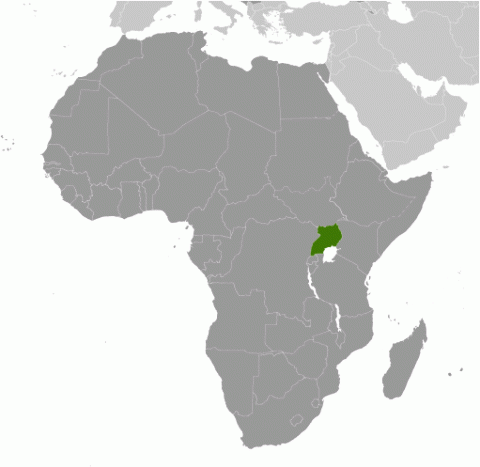Child Labor and Forced Labor Reports
Uganda


Moderate Advancement
In 2022, Uganda made moderate advancement in efforts to eliminate the worst forms of child labor. The City of Kampala published an ordinance to prohibit the employment of children in hazardous work, including activities such as working in rock quarries and restaurants, collecting and selling scraps, and domestic work. The government also secured seven convictions for crimes related to child trafficking for labor purposes, approved a child labor inspection checklist, and released the results of a 2021 baseline survey on child labor in the rice and sugarcane growing areas in eastern Uganda. In addition, a National Child Focused Research Agenda (2022–2026) was launched, which enables evidence-based programing and includes research questions on child labor. However, children in Uganda are subjected to the worst forms of child labor, including in commercial sexual exploitation, sometimes as a result of human trafficking. Children also perform dangerous tasks in gold mining. Although the government made meaningful efforts in all relevant areas during the reporting period, Uganda's minimum age for hazardous work does not meet the international standard as the Employment of Children Regulations permit a commissioner to allow children ages 12 and older enrolled in an educational training or apprenticeship program to engage in hazardous work. Moreover, the law only guarantees free education through the primary level, even though international standards require free basic education through lower secondary school. In addition, the lack of a centralized supervisory authority, along with inadequate funding, training, and resources, hampered the capacity of law enforcement agencies to conduct child labor inspections and investigations.
Table 1 provides key indicators on children’s work and education in Uganda.
| Children | Age | Percent |
|---|---|---|
| Working (% and population) | 5 to 14 | 22.2 (2,525,644) |
| Working children by sector | 5 to 14 | |
| Agriculture | 94.9 | |
| Industry | 1.8 | |
| Services | 3.3 | |
| Attending School (%) | 5 to 14 | 85.1 |
| Combining Work and School (%) | 7 to 14 | 25.9 |
| Primary Completion Rate (%) | 52.7 |
Source for primary completion rate: Data from 2017, published by UNESCO Institute for Statistics, 2023. (1)
Source for all other data: International Labor Organization's analysis of statistics from Labour Force Survey (LFS), 2016–2017. (2)
Based on a review of available information, Table 2 provides an overview of children's work by sector and activity.
| Sector/Industry | Activity |
|---|---|
| Agriculture | Cultivating and harvesting cocoa, coffee, corn, tea,† tobacco,† rice,† sugarcane,† and vanilla, and acting as scarecrows in rice fields (3-5) |
| Working with livestock, including herding cattle† (5) | |
| Fishing,† including catching,† smoking,† and selling fish, and paddling† and loading boats† (5,6) | |
| Collecting grasshoppers (5,7) | |
| Industry | Construction,† including making† and laying† bricks (5,8) |
| Quarrying stone† and limestone, mining gold, marble, charcoal, sand,† tin, and salt (5,9) | |
| Manufacturing, including working in carpentry workshops† (5,10,11) | |
| Services | Domestic work† (7,11,12) |
| Street work, including vending,† begging,† car washing,† working as porters,† scavenging,† collecting plastic bottles, and collecting and selling scrap metal (5,7,11-14) | |
| Working in hair salons, hotels,† restaurants,† bars,† and video halls† (5,11-14) | |
| Producing alcoholic beverages (5) | |
| Categorical Worst Forms of Child Labor‡ | Commercial sexual exploitation, sometimes as a result of human trafficking (5,15) |
| Forced labor in agriculture, fishing, cattle herding, working in bars and restaurants, begging, brickmaking, mining, stone quarrying, street vending, and domestic work (5,8,10,15) | |
| Use in the production of pornography and pornographic performances (11,12) | |
| Use in illicit activities, including smuggling, burglary, cattle theft, and car and house break-ins, each sometimes as a result of human trafficking (10-13) |
† Determined by national law or regulation as hazardous and, as such, relevant to Article 3(d) of ILO C. 182.
‡ Child labor understood as the worst forms of child labor per se under Article 3(a)–(c) of ILO C. 182.
In December 2022, military operations established that children had been recruited into ISIS-DRC from parts of Busoga in eastern Uganda, Kasese in western Uganda, and Wakiso and Luweero in central Uganda. The Office of the Director of Public Prosecutions is currently working on these cases. (5) After strong government encouragement following the COVID-19 pandemic, the Uganda Bureau of Statistics published its 2021 National Labor Force Survey during the reporting period. Survey results indicated that 39.5 percent of children ages 5–17 were engaged in some form of child labor in the country, a percentage that was more than double the percentage reported in the 2019/2020 National Household Survey published in 2021, and that the Karamoja region had the highest rate of child labor at 56 percent. (16,17)
Ugandan children are lured by human traffickers from rural to urban areas and subsequently exploited in forced labor and sex trafficking. Ugandan children are also victims of forced labor and sex trafficking in neighboring countries, such as Kenya and Somalia, and in the Middle East and South Asia. (5,15,18,19) Furthermore, human traffickers exploit children from neighboring countries, including Kenya, Rwanda, and Tanzania, in forced agricultural labor, domestic servitude, and commercial sexual exploitation in Uganda. (15,19) Children from rural areas, especially the Karamoja region, are vulnerable to human trafficking, in which they are forced into begging, street vending, domestic work, or commercial sexual exploitation. (10,15,18) NGO and media reports have indicated that children from Karamoja are also sold in open-air markets or through intermediaries and forced into domestic work, begging, cattle herding, and commercial sexual exploitation. (11,15,20) The Ugandan People's Defense Force noted that cattle rustlers in the Karamoja region recruit children, especially boys, for violent cattle raids. An unspecified number of these children have been killed during military operations against the cattle rustlers, and according to the Committee on Gender, Labor, and Social Development, cattle raids also increase children's vulnerability to human trafficking. (5) In other parts of the country, girls worked in gold mines in Karamoja in northern Uganda, and boys grazed cattle in Rwenzori in western Uganda. Meanwhile, children in the Bidibidi refugee settlement in northwestern Uganda were engaged in hazardous labor, including working on farms and as domestic workers, which may include working long hours and physical, verbal, and sexual abuse. (13,21)
While Ugandan law provides for free compulsory education, the cost of school supplies, uniforms, and other materials often impedes some children from attending school. Research found that these fees are paid directly to the schools, and if students are not able to pay the amount in full, they might be prevented from attending or completing their term. (5,22,23) Additional barriers to education for children include lack of teachers, poor school infrastructure, and lack of transportation, particularly in remote rural areas where children may have to walk very long distances to the nearest school. (11,12,24) Although free compulsory education laws apply equally to refugee children, research found that these children often are not enrolled in or not attending school. Girls, especially those in refugee camps, are at particular risk of being out of school and vulnerable to exploitation due to pressure to undertake domestic duties, gender-based violence, and harassment. (25,26) In addition, refugee children, particularly girls, may also face harassment due to their refugee status, and they may also experience language barriers. For a number of refugee settlements, such as Nakivale, schools are often located far from where refugees live and are inadequately equipped to meet the needs of the large student population. (5,27)
In late May 2023, Uganda enacted the Anti-Homosexuality Act, which allows for the prosecution and imprisonment of persons, including children, found to be committing or attempting to commit same-sex acts. (28) The law also requires mandatory reporting of those suspected of committing or intending to commit these acts. Research indicates that LGBTQI+ children are sometimes expelled or suspended from school, and this new law may increase discrimination against children and further interfere with their access to education. (29,30)
Uganda has ratified most key international conventions concerning child labor (Table 3).
| Convention | Ratification |
|---|---|
| ILO C. 138, Minimum Age | ✓ |
| ILO C. 182, Worst Forms of Child Labor | ✓ |
| UN CRC | ✓ |
| UN CRC Optional Protocol on Armed Conflict | ✓ |
| UN CRC Optional Protocol on the Sale of Children, Child Prostitution and Child Pornography | ✓ |
| Palermo Protocol on Trafficking in Persons |
The government has established laws and regulations related to child labor (Table 4). However, gaps exist in Uganda’s legal framework to adequately protect children from the worst forms of child labor, including the lack of free basic education guaranteed by law.
| Standard | Meets International Standards | Age | Legislation |
|---|---|---|---|
| Minimum Age for Work | Yes | 16 | Section 7 of the Children (Amendment) Act (31) |
| Minimum Age for Hazardous Work | No | 18 | Section 7 of the Children (Amendment) Act; Section 32 of the Employment Act; Regulations 5 and 8 of the Employment (Employment of Children) Regulations (31-33) |
| Identification of Hazardous Occupations or Activities Prohibited for Children | Yes | Regulation 6 and the First Schedule of the Employment (Employment of Children) Regulations; Section 7 of the Children (Amendment) Act (31,33) | |
| Prohibition of Forced Labor | Yes | Sections 2 and 5 of the Employment Act; Sections 3–5 of the Prevention of Trafficking in Persons Act (32,34) | |
| Prohibition of Child Trafficking | Yes | Section 8 of the Children (Amendment) Act; Sections 2–6 of the Prevention of Trafficking in Persons Act (31,34) | |
| Prohibition of Commercial Sexual Exploitation of Children | Yes | Section 8A of the Children (Amendment) Act; Sections 2–5 of the Prevention of Trafficking in Persons Act; Section 131 of the Penal Code; Section 14 of the Anti-Pornography Act (31,34-36) | |
| Prohibition of Using Children in Illicit Activities | Yes | Article 5(d) of the Prevention of Trafficking in Persons Act; Article 88 of the Narcotic Drugs and Psychotropic Substances (Control) Act (34,37) | |
| Minimum Age for Voluntary State Military Recruitment | Yes | 18 | Article 52(2)(c) of the Defense Forces Act (38) |
| Prohibition of Compulsory Recruitment of Children by (State) Military | N/A* | ||
| Prohibition of Military Recruitment by Non-state Armed Groups | Yes | Section 5(b) of the Prevention of Trafficking in Persons Act (34) | |
| Compulsory Education Age | No | 13‡ | Sections 2 and 10(3)(a) of the Education Act (22) |
| Free Public Education | No | Section 10(3)(a) of the Education Act (22) |
* Country has no conscription (38)
‡ Age calculated based on available information (22)
During the reporting period, the Kampala Capital City Child Protection Ordinance was published. The ordinance prohibits the employment of children in hazardous work, including activities such as working in rock quarries and restaurants, collecting and selling scraps, and domestic work. (39) The ordinance has a maximum 6-month prison penalty for violators. (39) In addition, Wakiso District drafted a child protection ordinance that is currently awaiting publication in the Uganda Gazette, which is the final stage before its implementation can begin. (5)
Uganda’s existing legal framework governing child labor does not meet international standards on a number of points. While Uganda has a list of hazardous occupations prohibited to children under the age of 18, Section 8 of the Employment of Children Regulations permits a commissioner to allow children ages 12 and older enrolled in an educational training or apprenticeship program to engage in hazardous work, in violation of international standards. (33) Children in Uganda are required to attend school only up to age 13, making children ages 13 to 15 vulnerable to child labor because they are not required to attend school while also not being legally permitted to work. Finally, although Uganda has adopted policies to extend universal education through the secondary level, by law free education is limited to the primary level. (22,40)
The government has established institutional mechanisms for the enforcement of laws and regulations on child labor (Table 5). However, gaps exist within the authority of enforcement agencies that may hinder adequate enforcement of their child labor laws.
| Organization/Agency | Role & Activities |
|---|---|
| Ministry of Gender, Labor, and Social Development (MGLSD) | Formulates, implements, and enforces labor inspection policies and laws related to working conditions through its Department of Labor, Industrial Relations and Productivity. (41,42) Includes the Industrial Court, which judges labor dispute cases that are referred by labor officers and district labor officers. Operates the Uganda Child Helpline known as Sauti. (5,7,19) |
| Ministry of Internal Affairs | Enforces criminal laws on the worst forms of child labor. The Uganda Police Force’s (UPF) Child and Family Protection Unit investigates forced labor cases, the Special Investigations Division and the Anti-Human Trafficking Desk investigate cases related to human trafficking and the use of children in illicit activities, and the Sexual Offenses Desk investigates commercial sexual exploitation. (19) |
| Office of the Director of Public Prosecutions | Prosecutes criminal cases related to the worst forms of child labor that are referred by UPF. (43) |
Labor Law Enforcement
In 2022, labor law enforcement agencies in Uganda took actions to address child labor (Table 6). However, gaps exist within the authority of the Ministry of Gender, Labor, and Social Development (MGLSD) that may hinder adequate labor law enforcement, including the ability to assess penalties.
| Overview of Labor Law Enforcement | 2021 | 2022 |
|---|---|---|
| Labor Inspectorate Funding | $320,000 (10) | $81,450 (5) |
| Number of Labor Inspectors | 173 (10) | 195 (5) |
| Mechanism to Assess Civil Penalties | No (44) | No (44) |
| Training for Labor Inspectors Provided | Yes (10) | Yes (5) |
| Number of Labor Inspections Conducted at Worksite | 542 (10) | 283 (5) |
| Number of Child Labor Violations Found | Unknown | 56 (5) |
| Number of Child Labor Violations for Which Penalties Were Imposed | Unknown | 0 (5) |
| Number of Child Labor Penalties Imposed that Were Collected | Unknown | 0 (5) |
| Routine Inspections Conducted | Yes (10) | Unknown |
| Routine Inspections Targeted | Yes (10) | Unknown |
| Unannounced Inspections Permitted | Yes (44) | Yes (44) |
| Unannounced Inspections Conducted | Yes (10) | Yes (5) |
| Complaint Mechanism Exists | Yes (10) | Yes (5) |
| Reciprocal Referral Mechanism Exists Between Labor Authorities and Social Services | Yes (10) | Yes (5) |
In 2022, the number of overall labor officers increased by 18; however, reports indicate that several districts still lack labor officers in general, and in districts with officers, the lack of funding often prevents them from carrying out their duties. Furthermore, although reports indicate that labor officer training is insufficient and that officers generally lack the expertise to follow through on child labor cases, during the reporting period, over 120 labor officers were trained to use a child labor inspection manual and on strategies to eliminate child labor. (5,10,11) From January to November 2022, the Uganda Child Helpline reported a total of 162 children engaged in child labor, including 107 found to be working as domestic workers. The helpline also reported an additional 144 child trafficking cases, including 55 children engaged in forced domestic work. (5)
Labor unions have noted that the number of inspections conducted is insufficient and that inspections are only carried out when complaints are received. (5,45) Labor inspectors in Uganda have the authority to inspect private farms and residences, but the MGLSD has noted that inspectors rarely exercise this authority despite the prevalence of child domestic work in the country. (11) Research indicates that Uganda does not have an adequate number of labor inspectors to carry out their mandated duties. (45-47) Given the lack of resources for inspections, local NGOs often train labor inspectors and even assist them in conducting child labor inspections.(5)
Uganda is signatory to ILO Convention 81 that requires labor inspection to be placed under the supervision and control of a central authority. (42,48) Research found, however, that coordination among the various agencies responsible for child labor law enforcement remains a challenge because labor officers are under district government authority, rather than under authority of the MGLSD. (49) For example, although under the Employment Act labor officers are required to submit monthly reports, in practice, the MGLSD does not receive labor reports from districts. (41) Research also found that child labor cases rarely reach the Industrial Court because of poor monitoring and the court's limited access to communities outside urban centers, where child labor is most likely to occur. (11) Overall, the government’s enforcement of labor laws and penalization of violations was inadequate, particularly in the informal sector in which most children work. (50)
Criminal Law Enforcement
In 2022, criminal law enforcement agencies in Uganda took actions to address child labor (Table 7). However, gaps exist within the operations of enforcement agencies that may hinder adequate criminal law enforcement, including official complicity in the commercial sexual exploitation of children.
| Overview of Criminal Law Enforcement | 2021 | 2022 |
|---|---|---|
| Training for Criminal Investigators Provided | Yes (10) | Yes (5) |
| Number of Investigations | 1,286 (5,51) | 532 (52) |
| Number of Prosecutions Initiated | 571 (51) | 115 (5) |
| Number of Convictions | 48 (51) | 7 (5) |
| Imposed Penalties for Violations Related to the Worst Forms of Child Labor | Yes (10) | Yes (10) |
| Reciprocal Referral Mechanism Exists Between Criminal Authorities and Social Services | Yes (10) | Yes (5) |
In 2022, the Office of the Director of Public Prosecutions reported that seven individuals were convicted of child trafficking for labor purposes. Three of these individuals received a 1-year prison term, another received a 2-year prison term, two others received a 7-year term, and another was fined approximately $540. (5) In addition, the MGLSD reported withdrawing, rehabilitating, and reintegrating 493 children from the streets of Kampala back into their communities, in collaboration with the Kampala Capital City Authorities. (5) Observers reported that police officers and immigration officials, particularly at airports and border crossings, have been known to accept bribes to facilitate human trafficking, including child trafficking, or to warn human traffickers of impending operations or investigations. During the reporting period, the government investigated seven government officials—including police officers, military officers, and public officials—involved in potential human trafficking crimes; all seven cases remained ongoing at the end of the reporting year. (53) Law enforcement agencies and civil society organizations have claimed that immigration officials have been known to facilitate human trafficking, including the trafficking of children, while research has also found limited cases of police allegedly complicit in the commercial sexual exploitation of child refugees. (15,52) Reports have also indicated that high-level government officials may have owned or been associated with labor recruitment companies and networks of traffickers that engage in child trafficking. However, during the reporting period, the Uganda Police Force (UPF) Anti-Trafficking Department reported a reduction in the number of these cases due to an increase in prosecution-led investigations, which has also increased collaboration between police and prosecutors. (15,52,54) The involvement of government officials in human trafficking networks can significantly impede criminal investigations into cases of the worst forms of child labor. (15) Uganda's State House Anti-Corruption Unit, which works on human trafficking issues on an ad hoc basis, has initiated investigations related to official complicity in human trafficking but has not made any of these reports public. (55,56)
According to the government, police officers identify and refer street children to probation officers and civil society organizations to place children in homes and shelters and do not keep them in detention facilities; however, some children may have been housed in juvenile rehabilitation centers because shelters are frequently full. Police intermittently rounded up street children, housed them in children’s homes and shelters for several days while social workers completed family tracing, and then returned them to their families. (5,50,56-58) Research found that some street children, including potential human trafficking victims and child laborers, have faced conflict with local authorities; however, in December 2022, the Constitutional Court declared the offenses of "rogues and vagabonds" in Uganda's Penal Code unconstitutional, and the UPF announced that it would no longer arrest individuals using these charges. (5,21,56,59) Reports have also indicated that investigators rarely follow up on reports of children involved in domestic work. When child domestic workers complain to their employers about not being paid, the employers may report the children to the police for theft, and police subsequently treat them as criminals rather than as victims who have not been paid for their work. (11)
Moreover, training of criminal investigators is insufficient, in part due to regular staff turnover and transfers. Some criminal law enforcement officials are not aware of key human trafficking laws, and some officers misclassify cases, conduct insufficient investigations, or encourage victims to accept payment from their traffickers to settle cases. (55,60)
The government has established a key mechanism to coordinate its efforts to address child labor (Table 8).
| Coordinating Body | Role & Activities |
|---|---|
| National Steering Committee on the Elimination of Child Labor | Coordinates child labor issues and implements the National Action Plan for the Elimination of Child Labor, including by setting policy priorities, securing resources for child labor programs, and coordinating with key stakeholders. Led by MGLSD, includes members from several ministries, including the Office of the Prime Minister, Ministry of Finance, Ministry of Local Government, and UPF. (11,61) In 2022, held three meetings, approved a child labor inspection checklist, released the results of a 2021 baseline survey by Platform for Labor Action on child labor in rice- and sugarcane-growing areas in eastern Uganda, and participated in the May 2022 Global Conference on the Elimination of Child Labor in South Africa. (5) |
During the reporting period, the National Child Well-Being Steering Committee established child well-being steering committees in 108 districts and in 1 city and established child well-being committees in 36 sub-counties. (5)
The government has established policies related to child labor (Table 9). However, policy gaps exist that hinder efforts to address child labor, including inconsistent implementation of national policies throughout the country.
| Policy | Description & Activities |
|---|---|
| National Action Plan for the Elimination of Child Labor (2020/2021–2024/2025) † | Launched in 2021 and developed in alignment with the country's National Development Plan, aims to focus government efforts on prevention, protection, rehabilitation, and reduction of the risk of child labor, with the goal of eliminating all forms of child labor by 2025. (62,63) In 2022, the government launched the ILO Social Finance Model to support implementation of the National Action Plan. (5) |
| National Child Policy | Seeks to coordinate the protection of child rights, focusing on abuse, neglect, exploitation, and violence. Includes prioritization of the elimination of child labor and was launched with an implementation strategy through 2025. (64,65) Seeks to outline the responsibilities of all stakeholders in implementing child-related policies and focuses on four basic children's rights: survival, development, protection, and participation. (64,65) During the reporting period, launched the National Child Focused Research Agenda (2022–2026), which supports and enables relevant research to support evidence-based programing. The research agenda was validated by the Interministerial Committee on the Implementation of the National Child Policy and includes research questions on child labor. (5) |
| National Action Plan for Prevention of Trafficking in Persons in Uganda (2019–2024) | Focuses on developing sustainable systems and structures to prevent human trafficking; improving capacity for the identification, protection of and support for victims; improving investigations and prosecutions; and establishing cooperative relationships with international stakeholders. Includes the National Referral Guidelines for Management of Victims of Trafficking, which seek to improve coordination among stakeholders responsible for providing services to victims and those responsible for prosecuting criminals. (66,67) The government continued to hold public awareness campaigns focusing on human trafficking in 2022, along with a variety of other activities to implement the National Action Plan for the Prevention of Trafficking in Persons in Uganda. (5) |
‡ The government had other policies that may have addressed child labor issues or had an impact on child labor. (68)
Despite the efforts to develop and implement a national action plan against child labor, because of the decentralized nature of inspections in Uganda, some districts have developed their own labor action plans that do not always reflect MGLSD priorities. (42)
In 2022, the government funded and participated in programs that include the goal of eliminating or preventing child labor (Table 10). However, gaps exist in these social programs, including the inadequacy of efforts to address the problem in all sectors.
| Program | Description & Activities |
|---|---|
| Accelerating Action for the Elimination of Child Labor in Supply Chains 2018–2022 (ACCEL Africa) | Launched in 2018, and formally implemented by ILO and the Ministry of Foreign Affairs of the Netherlands in Uganda in 2020 in partnership with the Government of Uganda and the Federation of Ugandan Employers. The Uganda portion of the $29 million, multi-country project targeted child labor in coffee and tea supply chains in the Mbale, Kabarole, Buikwe, Hoima, and Bushenyi districts. (13) In 2022, ILO supported implementation of key components of the National Action Plan for the Elimination of Child Labor (NAP II), including the ongoing review of the National Child Labor Policy of 2006, supporting labor inspections in 56 workplaces, including in tea and coffee plantations and factories, reviewing guidelines for labor inspectors on child labor, training trainers for 25 labor officers, and conducting joint field monitoring of children in the ACCEL Africa Project target districts. (5) |
| Uganda Child Helpline (Sauti)† | Funded primarily by UNICEF with in-kind contributions from MGLSD, comprises District Action Centers and a physical call center located in Wakiso that screens all calls for reported cases of child abuse. Caseworkers at District Action Centers follow up directly on cases of child abuse, including child labor and exploitation, assigned to them by the National Call Center and liaise with local authorities to address reported incidents. (69) From January to November 2022, the helpline reported a total of 162 child labor cases, 107 of which were engaged in domestic work. In addition, it further reported 144 child trafficking cases, including 55 engaged in forced labor related to domestic work. (5) |
| Back Home Campaign for Karamoja Children† | Government program that rescues Karamoja street children working in Kampala and places them in rehabilitation centers in Wakiso and Moroto districts before reuniting them with their families. (12,70) Remains inactive since it was stalled due to the COVID-19 pandemic. (5) |
For information about USDOL’s projects to address child labor around the world, visit https://www.dol.gov/agencies/ilab/ilab-project-page-search
† Program is funded by the Government of Uganda.
‡ The government had other social programs that may have included the goal of eliminating or preventing child labor. (71,72)
Although Uganda has implemented programs that address child labor, the scope of these programs is insufficient to fully address the extent of the problem, particularly in mining and commercial sexual exploitation. For example, the government lacks its own facilities to house child victims of labor exploitation or human trafficking and must instead rely on local community services organizations. (5,13) Furthermore, the MGLSD has noted that programs are concentrated in specific districts and thus do not cover child labor issues throughout the country. (5)
Based on the reporting above, suggested actions are identified that would advance the elimination of child labor in Uganda (Table 11).
| Area | Suggested Action | Year(s) Suggested |
|---|---|---|
| Legal Framework | Accede the Palermo Protocol on Trafficking in Persons. | 2013 – 2022 |
| Ensure that only minors ages 16 and older who have received adequate, specific instruction or vocational training are permitted to perform hazardous work, and that their health, safety, and morals are fully protected. | 2017 – 2022 | |
| Increase the compulsory education age from 13 to 16 to match the minimum age for work. | 2021 – 2022 | |
| Establish by law free basic public education. | 2009 – 2022 | |
| Enforcement | Enhance the effectiveness of the inspectorate to enforce labor laws, including by establishing a mechanism to assess child labor violation penalties. | 2017 – 2022 |
| Provide the labor inspectorate with sufficient funding and resources at the district level to ensure that inspectors are present in all districts and are able to carry out their duties. | 2013 – 2022 | |
| Ensure that an adequate number of labor inspections are conducted and strengthen the labor inspectorate by initiating routine and targeted inspections based on the analysis of data related to risk-prone sectors and patterns of serious incidents. | 2021 – 2022 | |
| Ensure that the inspectorate is using its existing authorities to inspect private farms and homes and to conduct sufficient routine and unannounced inspections, including in the informal sector. | 2017 – 2022 | |
| Significantly increase the number of labor inspectors from 195 to 275 to ensure adequate coverage of the labor force. | 2009 – 2022 | |
| Improve coordination between national- and district-level child labor enforcement bodies to ensure that relevant data are shared and that child labor inspections are prioritized across the country. | 2019 – 2022 | |
| Ensure that child labor cases reach the Industrial Court and that penalties are assessed by addressing monitoring issues and improving the court's reach outside urban centers. | 2019 – 2022 | |
| Continue to increase efforts to ensure that public officials who facilitate or participate in human trafficking or the worst forms of child labor are held accountable, including officials who have ties with labor recruitment companies, and publish relevant reports. | 2019 – 2022 | |
| Strengthen mechanisms for following up on child labor claims and referring street children, including potential human trafficking victims, to social services providers, and prevent these children from being detained and abused by police. | 2015 – 2022 | |
| Increase the capacity of criminal law enforcement agencies to respond to the worst forms of child labor by dedicating more personnel to worst forms of child labor cases and improving training for criminal law enforcement staff. | 2020 – 2022 | |
| Government Policies | Ensure that district labor action plans reflect the Ministry of Gender, Labor, and Social Development's priorities. | 2018 – 2022 |
| Social Programs | Enhance efforts to eliminate barriers and make education accessible for all children by defraying informal costs borne by families, including supplies, uniforms, and materials; addressing physical and sexual violence; and ensuring sufficient teachers, infrastructure, and transportation in rural areas. | 2012 – 2022 |
| Enhance efforts to ensure that refugee children have equal access to educational opportunities by addressing gender-based violence and exploitation, harassment, and refugee discrimination; accommodating the language needs of refugee students; and ensuring that there are well-equipped schools accessible to refugee settlements. Further ensure children have equal access to school regardless of gender identity or sexual orientation. | 2012 – 2022 | |
| Ensure the availability of shelters for victims of child labor, including child trafficking victims. | 2017 – 2022 | |
| Expand existing social programs to address the scope of the child labor problem, particularly in mining and commercial sexual exploitation, in all areas of the country. | 2009 – 2022 | |
| Ensure that activities are undertaken to implement key social programs to address child labor during the reporting period and make information about implementation measures publicly available. | 2021 – 2022 |
- UNESCO Institute for Statistics. Gross intake ratio to the last grade of primary education, both sexes (%). Accessed March 15, 2023. For more information, please see “Children's Work and Education Statistics: Sources and Definitions” in the Reference Materials section of this report.
http://data.uis.unesco.org/ - ILO. Analysis of Child Economic Activity and School Attendance Statistics from National Household or Child Labor Surveys. Original data from Labour Force Survey (LFS), 2016–2017. Analysis received March 2023. Please see “Children's Work and Education Statistics: Sources and Definitions” in the Reference Materials section of this report.
- Karakire, Diana Taremwa. How COVID-19 has expedited child labour in Uganda’s coffee industry. Mbale: The Independent. September 10, 2021.
https://www.independent.co.ug/how-covid-19-has-expedited-child-labour-in-ugandas-coffee-industry/ - Agiresaasi, Apophia. For many, hard labor takes the place of homework. Mayuge: Global Press Journal. August 26, 2021.
https://globalpressjournal.com/africa/uganda/many-hard-labor-takes-place-homework/ - U.S. Embassy- Kampala. Reporting. February 21, 2023.
- ICF Macro. Child Labor in Fishing Industry in Uganda. September 16, 2011. Source on file.
- Uganda Child Helpline official. E-mail communication with USDOL official. April 26, 2019.
- Uganda Bureau of Statistics. National Labour Force and Child Activities Survey 2011/12. July 2013. Source on file.
- World Education/Bantwana. Africa Youth Empowerment Development Initiative Baseline Report. December 2014. Source on file.
- U.S. Embassy- Kampala. Reporting. February 10, 2022.
- U.S. Embassy- Kampala. Reporting. January 9, 2020.
- U.S. Embassy- Kampala. Reporting. January 11, 2019.
- U.S. Embassy- Kampala. Reporting. January 15, 2021.
- U.S. Embassy- Kampala official. E-mail communication to USDOL official. June 22, 2023.
- U.S. Department of State. Trafficking in Persons Report- 2022: Uganda. Washington, D.C., July 19, 2022.
https://www.state.gov/reports/2022-trafficking-in-persons-report/uganda/ - Government of Uganda. The Uganda National Household Survey 2019–2020. Uganda Bureau of Statistics. August 2021.
https://www.ubos.org/wp-content/uploads/publications/09_2021Uganda-National-Survey-Report-2019-2020.pdf - Government of Uganda. National Labour Force Survey 2021 – Main Report. Uganda Bureau of Statistics, November 2022.
https://www.ubos.org/wp-content/uploads/publications/11_2022NLFS_2021_main_report.pdf - U.S. Embassy- Kampala. Reporting. February 12, 2021.
- U.S. Embassy- Kampala official. Official communication to USDOL official. June 8, 2022.
- Mafabi, David. Child trafficking is big business in Karamoja. PML Daily. September 29, 2018.
http://www.pmldaily.com/features/2018/09/child-trafficking-is-big-business-in-karamoja.html - U.S. Embassy- Kampala official. E-mail communication to USDOL official. June 17, 2021.
- Government of Uganda. The Education (Pre-Primary, Primary and Post-Primary) Act, 2008. Act 13. Enacted: August 29, 2008.
http://www.unesco.org/education/edurights/media/docs/5d1b721a509097c2833561341ead3d788906cf4a.pdf - Athumani, Halima. Whatever happened to the teens who endured the world's longest COVID school closure? September 1, 2022.
https://www.npr.org/sections/goatsandsoda/2022/09/01/1119945999/whatever-happened-to-the-teens-who-endured-the-worlds-longest-covid-school-closu - Child Protection Manager. Uganda Women's Effort to Save Orphans (UWESO). Interview with USDOL official. December 12, 2018.
- UNHCR. Uganda Monthly Update: Protection - Education. October 2018.
https://data2.unhcr.org/en/documents/download/67166 - UNHCR. Uganda Monthly Update: Protection - Education. August 2018.
https://reliefweb.int/sites/reliefweb.int/files/resources/66181.pdf - UNHCR. Uganda Refugee Response Monitoring, Settlement Fact Sheet: Nakivale. June 2018.
https://reliefweb.int/sites/reliefweb.int/files/resources/66773.pdf - Government of Uganda. Anti-Homosexuality Act, 2023. Enacted: May 30, 2023. Source on file.
- Wepukhulu, Kthatondi Soita. LGBTIQ students kicked out of school in East Africa are fighting back. February 11, 2022.
https://www.opendemocracy.net/en/5050/lgbtiq-students-kicked-out-of-school-in-east-africa-are-fighting-back/ - Democracy Now! Full Interview: Frank Mugisha on New Anti-LGBTQ Bill in Uganda That Could Impose Death Penalty. April 17, 2023.
https://www.democracynow.org/2023/4/17/full_interview_frank_mugisha_on_new - Government of Uganda. The Children (Amendment) Act, 2016. Enacted: May 20, 2016.
https://www.ilo.org/dyn/natlex/docs/ELECTRONIC/104395/127307/F-171961747/UGA104395.pdf - Government of Uganda. The Employment Act, 2006. Enacted: June 8, 2006.
http://www.ilo.org/dyn/natlex/docs/SERIAL/74416/76582/F1768664138/UGA74416.pdf - Government of Uganda. The Employment (Employment of Children) Regulations, 2012. Enacted: April 20, 2012. Source on file.
- Government of Uganda. The Prevention of Trafficking in Persons Act, 2009. Act 7. Enacted: October 23, 2009. Source on file.
- Government of Uganda. Penal Code Act (Cap. 120) of Uganda. Enacted: June 15, 1950.
https://www.refworld.org/docid/59ca2bf44.html - Government of Uganda. The Anti-Pornography Act, 2014. Enacted: February 6, 2014. Source on file.
- Government of Uganda. The Narcotic Drugs and Psychotropic Substances (Control) Act, No. 3 of 2016.
https://ulii.org/akn/ug/act/2016/3/eng@2016-02-05 - Government of Uganda. The Uganda Peoples' Defence Forces Act, 2005. Enacted: September 2, 2005.
https://ulii.org/akn/ug/act/statute/1992/3/eng@2000-12-31 - Government of Uganda. The Kampala Capital City (Child Protection) Ordinance, 2022. May 27, 2022. Source on file.
- New Vision. Govt drives reforms in education sector. January 23, 2020.
https://www.newvision.co.ug/news/1513894/govt-drives-reforms-education-sector - Ministry of Gender, Labor and Social Development official. Interview with USDOL official. December 12, 2018.
- ILO. Uganda - Labour Inspection Structure and Organization.
https://www.ilo.org/global/topics/safety-and-health-at-work/country-profiles/africa/uganda/WCMS_209370/lang--en/index.htm - U.S. Embassy- Kampala. Reporting. February 12, 2018.
- Government of Uganda. The Employment Act, 2006.
https://www.ilo.org/dyn/natlex/docs/ELECTRONIC/74416/127308/F-831045940/UGA74416.pdf - U.S. Department of State. Country Reports on Human Rights- 2022: Uganda. Washington, D.C., March 20, 2023.
https://www.state.gov/reports/2022-country-reports-on-human-rights-practices/uganda - ILO modelled estimates and projections (ILOEST) – Population and labour force. Accessed January 25, 2022. Labor force data is modelled on a combination of demographic and economic explanatory variables by the ILO. Please see "Labor Law Enforcement: Sources and Definitions" in the Reference Materials section of this report.
https://ilostat.ilo.org/data/ - UN. World Economic Situation and Prospects 2022 Statistical Annex. New York, 2022. Please see "Labor Law Enforcement: Sources and Definitions" in the Reference Materials section of this report.
https://www.un.org/development/desa/dpad/publication/world-economic-situation-and-prospects-2022/ - ILO Committee of Experts. Individual Observation concerning Labour Inspection Convention, 1947 (No. 81) Uganda (ratification: 1963). Published: 2019.
https://www.ilo.org/dyn/normlex/en/f?p=1000:13100:0::NO:13100:P13100_COMMENT_ID:3791190 - U.S. Embassy- Kampala official. E-mail communication to USDOL official. February 1, 2018.
- U.S. Department of State. Country Reports on Human Rights Practices- 2021: Uganda. Washington, D.C., April 22, 2022.
https://www.state.gov/reports/2021-country-reports-on-human-rights-practices/uganda/ - Government of Uganda. Uganda Police Force Annual Crime Report 2021. May 2022. Source on file.
- U.S. Embassy- Kampala. Reporting. March 27, 2023.
- U.S. Department of State. Trafficking in Persons Report- 2023: Uganda. Washington, D.C., June 15, 2023.
https://www.state.gov/reports/2023-trafficking-in-persons-report/uganda/ - U.S. Embassy- Kampala official. E-mail communication to USDOL official. July 11, 2019.
- U.S. Embassy- Kampala. Reporting. February 14, 2020.
- U.S. Department of State. Trafficking in Persons Report- 2021: Uganda. Washington, D.C., July 1, 2021.
https://www.state.gov/reports/2021-trafficking-in-persons-report/uganda/ - U.S. Embassy- Kampala. Reporting. February 28, 2022.
- U.S. Embassy- Kampala official. E-mail communication to USDOL official. March 19, 2019.
- Ngwomoya, Amos. The plight of Kampala street children. Daily Monitor. August 22, 2019.
https://www.monitor.co.ug/SpecialReports/The-plight-of-Kampala-street-children/688342-5245322-128o3xo/index.html - U.S. Embassy- Kampala. Reporting. January 16, 2018.
- Trumpet News. Government ramps up Efforts to fight Child labour. October 5, 2021.
https://trumpetnews.co.ug/government-ramps-up-efforts-to-fight-child-labour/ - Government of Uganda. Uganda National Action Plan for Elimination of Child Labor 2020-2025. Ministry of Gender, Labour, and Social Development. April 2021. Source on file.
- Aryatwijuka, Phillo. Uganda's National Plan of Action on Child Labor will strengthen country's prevention and protection of children at risk and working children mechanisms. ILO. June 1, 2021.
https://www.ilo.org/africa/technical-cooperation/accel-africa/WCMS_799733/lang--en/index.htm - Government of Uganda. National Child Policy 2020. January 1, 2020.
https://bettercarenetwork.org/sites/default/files/2020-10/National Child Policy 2020.pdf - Government of Uganda. National Child Policy Implementation Plan 2020–2025. January 1, 2020.
https://bettercarenetwork.org/sites/default/files/2020-10/National Child Policy Implementation Plan 2020-2025 (1).pdf - International Organization on Migration. With Support of BMM Programme, Uganda Launches Action Plan on Trafficking. August 3, 2020.
https://uganda.iom.int/news/support-bmm-programme-uganda-launches-action-plan-trafficking#:~:text=With Support of BMM Programme, Uganda Launches Action Plan on Trafficking&text=The Uganda Government on Thursday,Management of Victims of Trafficking - Government of Uganda. National Action Plan for Prevention of Trafficking in Persons in Uganda 2019-2024. 2019. Source on file.
- Government of Uganda. The National Action Plan on Business and Human Rights. Ministry of Gender, Labour, and Social Development. August 2021. Source on file.
- Uganda Child Helpline official. Phone interview with USDOL official. March 28, 2019.
- Asiimwe, Bridget. Government resumes forceful repatriation of street children. IntelPost. June 2, 2018. Source on file.
- Uganda Youth Development Link (UYDEL). Uganda Youth Development Link (UYDEL) – Profile. 2023.
https://www.uydel.org/ - World Education. Better Outcomes for Children and Youth in Eastern and Northern Uganda.
https://worlded.org/project/better-outcomes-for-children-and-youth-in-eastern-and-northern-uganda/#:~:text=The USAID Better Outcomes for,in eastern and northern Uganda
your hand? Download ILAB's Sweat & Toil App today!














